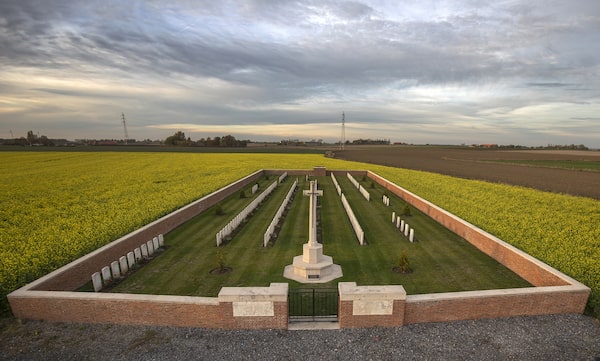Nathan Greenfield is the Canadian correspondent for University World News and the author of several books about Canada’s role in the two world wars.
The masks the residents of Ypres, Belgium, don against COVID-19 are more than a necessary annoyance. They are a tangible link to the thousands of dead that fill the 160 cemeteries in and around this ancient Flemish town and to thousands of the more than 55,000 names incised into the granite curtains of the 14.5-metre-high Menin Gate. These men died “flound’ring like a man in fire or lime” in poison gas attacks, in the words of poet Wilfred Owen.
Today’s cloth masks, the 35,000 Yperlings know, resemble the urine-soaked bandanas and handkerchiefs that Canadian troops breathed through on April 22 and 24, 1915, during the first and second gas attacks in history. As clouds of chlorine gas rolled over their trenches, these makeshift gas masks allowed the untried Canadians to hold off the Kaiser’s army, which could have pinched off the Ypres Salient, likely resulting in the capture of the Canadian army and tens of thousands of British troops. Of the 6,900 Canadian names inscribed on the gate, which memorializes those who have no known grave, 1,300 died during this, the Second Battle of Ypres.
Pedestrians pass the Menin Gate Memorial where the names are engraved of about 56,000 fallen soldiers of Great Britain and its Empire who died during the Great War of 1914-1918 and who have no own grave, in Ypres, Belgium, on Oct. 31, 2003.YVES LOGGHE/AP
Eleven years after the guns fell silent in 1918, at sunset on Nov. 11, 1929, the road under the Menin Gate was closed for the first of what would become the only daily civilian commemoration of the fallen of the Great War. Rain or shine, for almost four thousand nights – until Ypres fell to Germany’s Wehrmacht in May, 1940 – as dignitaries and visitors stood silent, four buglers honoured the men who died around Ypres and in the mud of nearby Passchendaele by blowing the Last Post.
During the German occupation, the Last Post Association paused the ceremony, which association president Benoit Mottrie notes “is hardly pro-German.” The tradition continued, however, at Brookwood Military Cemetery in Surrey, England, where once a week or every two weeks, a bugler would sound the call over thousands of graves – some holding Canadians from the First World War and, after August, 1942, 43 containing soldiers mortally wounded at Dieppe. On Sept. 6, 1944, with the sounds of war still rolling over Ypres, as Polish forces liberated the town, unbidden, a lone bugler stood under the Menin Gate and blew the call.
On many nights (including when I visited in 2007 and 2015), groups of school children – from Belgium, Britain and Canada – stand beneath the mausoleum-cum-gate in hushed silence. After the last sombre note fades away, they lay wreaths beneath names such as Private Ezra Chard (2nd Battalion) of Frankford, Ont. Both before and after the ceremony, visitors, myself included, run fingers over these names, a reverent pause that seems to erase the century since these men drew their last painful breaths.

Buffs Road British Military Cemetery in Flanders Fields is surrounded by cultivated fields on Nov. 06, 2018 in Ypres, Belgium.Christopher Furlong/Getty Images
Last March, as COVID-19 numbers prompted a national shutdown, Mr. Mottrie was determined that the ceremony continue. “We have good contacts and were supported by the burgomeister [mayor] and the government of Flanders, which allowed us to continue with a lone bugler,” he told me.
The bugler was, however, never quite alone. Standing beyond the gate were scores of physically distanced Yperlings. According to Dominiek Dendooven, curator of the In Flanders Fields Museum, “even on the coldest and darkest night of the lockdown, there were always people, locals. Some were from the chocolate shops on the square, who, with the town all but deserted, had the time to come stand outside the gate listening to this single man blow his bugle. With the space under the gate empty, the sound resonated, making it even more mournful than when there is an audience.”
In mid-May, three buglers were allowed, and in July they were joined by 156 physically distanced officials and members of the public, including the Canadian and New Zealand ambassadors on Canada Day. Two weeks ago, mounting COVID-19 numbers prompted another national shutdown and the ceremony was reduced to two buglers, with no audience under the gate.
About the time we gather around our televisions to watch the scaled-back Remembrance Day ceremony at the War Memorial in Ottawa, in Ypres, one bugler will be readying to walk under the Menin Gate. On the closed Menin Road, facing thousands of names, he will put his silver bugle to his lips and blow the call, beginning with B flat. Like the generations of Dutch schoolchildren who tend the graves of the Canadians who died liberating Holland, the Last Post Association ensures that these Great War soldiers will not stay in solitary silence, forgotten. For its founding documents state that buglers will “continue with the daily ceremony until eternity.”
Keep your Opinions sharp and informed. Get the Opinion newsletter. Sign up today.